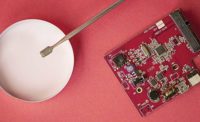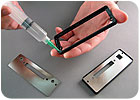
In assembly operations, it pays to be fast. Spend less time putting a product together, and that product will cost less to produce. This bit of conventional wisdom explains the growing popularity of fast-cure adhesives, which can save significant amounts of assembly time.
How much time? The fastest two-part epoxies have fixture or handling times as low as one to two minutes, while comparable conventional epoxies could require 15 minutes or more. Fast curing one-part epoxies can fully cure in minutes at 125 C, which can save an hour or more of cure time vs. conventional one-part materials. Similar savings can be achieved with speedy silicones that set up in minutes rather than the more typical one to two hours or more. Other adhesives, including cyanoacrylates and UV-curables, are also inherently fast, with cure times measured in seconds or minutes. All these time savings can improve assembly throughput by a large margin, which gives fast-cure products a compelling value proposition.
Even so, engineers should always question the need for speed when selecting adhesives. For all their benefits, fast-cure adhesives have physical property trade-offs that make them inappropriate for certain bonding, sealing and potting applications. What’s more, there are some scenarios where too fast a cure will actually complicate assembly operations and require the use of automated mixing and dispensing equipment.
With those caveats in mind, here’s an overview of fast-cure adhesives and how to tell when faster really isn’t better.
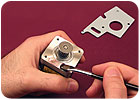
For all their benefits, fast-cure adhesives have physical property trade-offs that make them inappropriate for certain bonding, sealing and potting applications.
Fast-Cure Families
Like their slower curing counterparts, fast-cure adhesives are available in a wide range of one- and two-part formulations. Beyond their potential to save handling and cure time, each formulation has its own strengths and weaknesses.In general, one-part fast-cure adhesives earn high marks for ease of use, since they eliminate the need for mixing and cut fixturing time significantly. On the other side of the balance sheet, they have a more limited range of physical and mechanical properties than comparable two-part formulations. And because their cure reaction is exothermic, or heat generating, one-part fast-cure products are not the best choice for many potting applications.
Two-part fast-cure products are also not a good fit for most potting applications, owing to their exothermic cure mechanism. Moreover, two-part products sacrifice some ease of use because they require precise mixing on the factory floor. For high production volumes, they may not be compatible with manual mixing and dispensing methods. On the plus side, two-part products are far more versatile and offer a broader range of properties than the one-part fast-cure products-though not nearly as broad as standard two-part epoxies.
Fast-cure adhesives often require special equipment for dispensing and curing, so their use should hinge on an economic decision that balances the savings from shorter cure times against the added capital expense. In many assembly applications, the economics will make sense. In others, they may not. Applications with very low production volumes, for example, may be unable to justify higher adhesive costs through improvements to assembly throughput. The same reasoning goes for applications with a small number of bonded joints or applications that are simply not a significant bottleneck in the overall production process.
The most commonly used fast-cure products include:
One-part epoxies. Fully curing in two to 10 minutes upon exposure to heat, these adhesives can save hours of cure time vs. a standard one-part epoxy. In addition to the speedy cure, they also offer a controllable working time, since they don’t cure until exposed to a 250 F heat cycle. In applications with complex assemblies or fixturing procedures, a controllable working time can be more than enough to justify the use of this adhesive.
However, the need for heating in an oven can rule out some thermally sensitive applications. These adhesives also have a more limited range of mechanical, physical and specialty properties than standard cure epoxies. Applications needing enhanced electrical properties, maximum chemical resistance or the utmost bond strength may be better served by a standard epoxy.
One-part silicones. These adhesives typically reach a tack-free state in three to 15 minutes. By contrast, comparable moisture-curing standard silicones can take hours to set up and days to fully cure. One-part fast-cure silicones are room temperature vulcanizing, so they can be a valuable option in applications where a heat cycle would be damaging. And, because most fast-cure silicones do not release acetic acid during the cure process, they can be a good choice for electronics applications that are sensitive to corrosion.
On the downside, these are among the most costly of fast-cure adhesives, and their moisture cure makes open time subject to humidity levels, which can be difficult or costly to control.
Cyanoacrylates (CA). Setting up in less than a minute and reaching a full cure in a few minutes, CA adhesives certainly qualify as fast curing. They are also among the simplest to apply, with no need for ovens and no inherent need for specialized dispensing equipment. Over the years, they’ve staked out a place in fast-moving assembly lines for medical devices, electronics and industrial applications.
Their chief drawback is that they have a somewhat limited range of properties. Compared with epoxies and silicones, CA adhesives are brittle, with poor resistance to impacts, thermal cycling and high temperatures. They have very limited gap-filling capabilities. Finally, CAs also have an erratic resistance to moisture, so they are not the safest choice for use in consistently wet or humid environments.
UV curables. Once exposed to ultraviolet light, these one-part adhesives cure almost instantly. When fully cured, they have a number of beneficial properties, including optical clarity, moisture resistance and strong bonds to many different substrates. They also have superior chemical resistance, though not quite up to the level of standard epoxies. Because they require UV light to fully cure, they offer good control of open time.
But, they can be problematic in applications where the joint design or depth creates shadows that light cannot reach. However, good design practice can limit these shadows. There are also “dual-cure” products available that combine a light cure with a secondary heat cure. These can be a good workaround for designs with shadows, as long as the assembly can tolerate the heat. UV curables are also among the more expensive fast-cure products.
Two-part epoxies. With set up times as fast as a minute and no heat cycle to initiate the cure, two-part fast-cure epoxies can be a good choice in applications that cannot use a one-part epoxy for reasons of thermal sensitivity. The two-part epoxies also have the best balance of strength, thermal, chemical and electrical properties in the entire fast-cure class, so they can be a good choice in applications that run up against mechanical or physical property limitations with other fast-cures.
The one hitch with the two-part formulations is that they require mixing. If done manually, which is not recommended in most production applications, mixing can introduce errors into the assembly process. If done automatically, mixing requires costly dispensing equipment. The speed and performance of two-part fast-cure epoxies tend to offset the difficulties of mixing in applications that have both assembly bottlenecks and stringent property requirements. It’s also worth noting that two-part fast epoxies, while they don’t require heat to initiate the cure, will reach their maximum physical properties if they are subjected to a post-cure heat cycle.
Two-part silicones. Two-part silicones also cure in a matter of minutes and offer a favorable balance of mechanical and physical properties, though not quite on the same level as epoxies. The same issues associated with mixing apply with these materials, too. They have been used successfully in electronics and other thermally sensitive bonding applications.
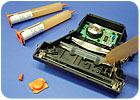
One-part epoxies cure fully in two to 10 minutes upon exposure to heat, saving hours of cure time vs. standard one-part epoxies.
Curing Common Mistakes
In their zeal to lower assembly costs, engineers will sometimes overemphasize cure speed. However, this tendency can lead to the use of fast-cure products where they are not the ideal choice based on the application’s functional requirements or assembly methods.Engineers who focus too much on cure speed most often get into trouble with CAs. We’ve seen these fast-curing adhesives specified for completely inappropriate applications-including medical devices that require autoclaving or assemblies subjected to high impact loads.
Fast-cure epoxies can likewise be misapplied if they are specified without regard to property trade-offs. These epoxies perform well enough that these trade-offs don’t come into play in most applications, but there are times when application requirements require a slower curing epoxy that maximizes properties.
The misuse of fast-cure adhesives doesn’t always come down to their end-use properties. One common mistake involves a failure to account for open-time needs during the assembly process. It’s counterintuitive, but a fast-cure can actually hinder smooth, cost-effective assembly operations if it leaves no time to position parts correctly in a fixture. Savvy engineers will intentionally pick slower curing adhesives with longer open times when confronted with difficult fixturing processes. In these cases fixturing difficulties, not cure time, drives the cost.
Think of these property trade-offs and fixturing issues as speed bumps that only occasionally slow down the assembly process. In many medical, electronic and industrial applications, these factors won’t put any practical limits on the use of fast-cure adhesives, allowing them to dramatically raise the speed limit of your assembly process.
For more information on adhesives, call Master Bond at 201-343-8983 or visitwww.masterbond.com.
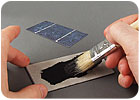
In general, one-part fast-cure adhesives earn high marks for ease of use. On the other hand, they have a more limited range of physical and mechanical properties than comparable two-part formulations.
ASSEMBLY ONLINE
For more information on adhesive bonding, visit www.assemblymag.com to read these arti-cles:•Epoxies: One Component or Two?
•Adhesives for Harsh Environments.
•Dispensing: Perfecting the Potting Process.
